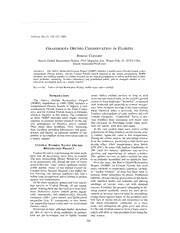
Grassroots Orchid Conservation in Florida PDF
Preview Grassroots Orchid Conservation in Florida
Selbyana 26(1,2): 326-327. 2005. GRASSROOTS ORCHID CONSERVATION IN FLORIDA ROBERT CLIFFORD Native Orchid Restoration Project, 1916 Magnolia Ave. Winter Park, FI. 32792 USA. Email: [email protected] ABSTRACT. The Native Orchid Restoration Project (NORP) includes a southwestern Rorida branch, a new southeastern Rorida branch, and the Central Rorida branch featured in this poster presentation. NORP members are working together to further research on the natural propagation of native orchids and to share three problems-financing, facilities (laboratory and greenhouse areas), and an adequate number of vol unteers to accomplish tasks in a timely manner. Key words: Native Orchid Restoration Project, buffer zone, native orchids INTRODUCTION areas. Native orchids survive, as long as such areas are not mowed early in the orchid's growth The Native Orchid Restoration Project season to keep highways "beautiful" or sprayed (NORP), established in 1999-2000, includes a with herbicide and pesticide to control mosqui southwestern Florida branch in Naples, a new toes. New residents moving to the state consider southeastern Florida branch in the Dade County these chemical aides a necessity, but Florida area, and the Central Florida branch in Orlando, Crackers (descendants of early settlers) did well which is featured in this article. The volunteers without chemicals. "Controlled" burns to pre in these NORP branches have begun working vent wildfires from damaging new home sites together to promote further research on the nat that encroach on forestland create many prob ural propagation of Florida's native orchids. lems for nature, both flora and fauna. They share three problems. First, financing; then, facilities including laboratories and green In the east central ridge area, native orchid houses, and finally, an adequate number of vol populations of long standing are becoming near unteers to accomplish orchid restoration tasks in ly extinct. Again the cause is low temperature. a timely manner. During the winter season, the prevailing wind is from the northwest, producing a chill factor and drying effect when temperatures drop below CENTRAL FLORIDA NATIVE ORCHID 32°F (O°C). In areas with natural windbreaks of RESTORATION PROJECT 200 yards (or meters), epiphytes can survive, Central Florida is experiencing the same prob growing and reproducing in natural colonies. lems that all developing areas have to combat. This applies not only to native orchids but also The area surrounding Disney World has grown to an endemic bromeliad and an epiphytic fern. at an exponential rate during the past 35 years, Over the years, the Native Orchid Restoration growth that has "cost" native epiphytes consid Project (NORP) of Central Florida has tried erable habitat. Areas of lost habitat exceed de many methods to reintroduce epiphytic orchids. veloped areas, because frequent cold nights, be A "sticker solution" of soap has been used to low freezing, can damage epiphytes that lack a increase water absorption by plants. Production buffer zone around their native habitat to protect methods include raising protocorms in lab flasks against low temperatures. with standard media and nutrients and placing Of the three epiphytic genera and four species seedlings of various sizes-all with minimal that survive in Central Florida, all are endan success. Currently the group is attempting to de gered. Among these are Harisella porrecta (leaf velop natural symbiotic media for seed devel less), Habenaria repens (which grows aquati cally, terrestrially, and epiphytically), Encyclia opment to increase survival rates by inoculating tampensis (100+ color forms), and Epidendrum young plants against many of the problems they magnoliae (syn. E. conopseum) in two forms, will face in nature but do not experience in the var. magnoliae (green color) and var. mexicanum lab. Such inoculation, conducted on a mass (bronze color). scale, will strengthen the gene pool and allow Terrestrial orchids, although highly disturbed, for the sale of plant material from a legal source, are able to survive along roadsides, in pasture which will slow or stop poachers from being the land not yet developed, and in lightly weeded only source. 326 SECOND IOCC PROCEEDINGS 327 CONCLUSION tors, along with the general public on what is happening to native habitats in Florida and on The group has short and long-term goals: pro ways to prevent further loss. Education is the key ducing strong plant material to improve the gene to correcting the damage that has resulted from pool on installation; providing a legitimate source years of misinformation about native plants at all of native species for the public market place, with levels. A balanced conservation effort is needed strong, new plants for future breeding stock; and rather than a continual one-upmanship to be the educating the agricultural and governmental sec- final preserver of nothing.
